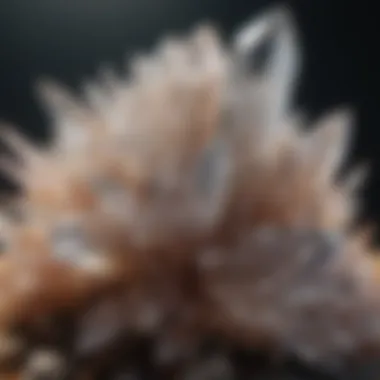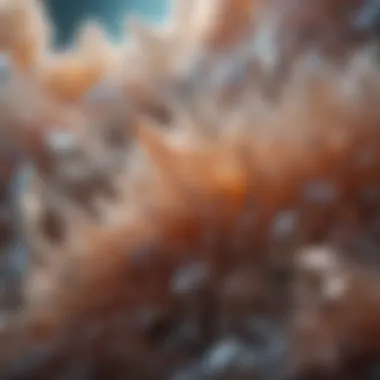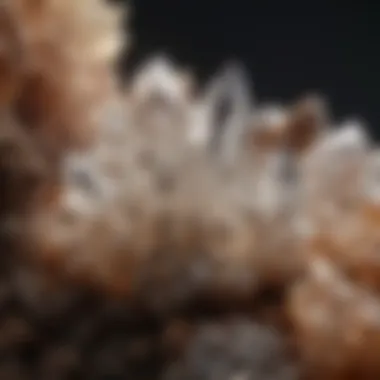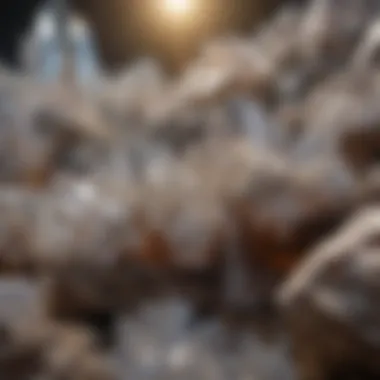Unveiling the Enigmatic Beauty of Quartz Crystal Clusters


Rock and Fossil Identification
Quartz crystal clusters are a mesmerizing wonder of nature, captivating both geology enthusiasts and crystal healers with their intricate formations and metaphysical properties. When it comes to identifying these fascinating specimens, there are key characteristics to look for. Quartz crystal clusters typically exhibit multiple points growing from a central matrix, creating a cluster-like appearance. The crystals themselves are often transparent or translucent, with a hexagonal shape due to their molecular structure. Tools such as magnifying glasses and UV lights can aid in identifying the clarity and purity of quartz crystal clusters.
Geological Insights
Delving deeper into the geological aspects of quartz crystal clusters unveils a world of ancient formations and processes. These clusters form in cavities within rocks, where silicon dioxide-rich solutions slowly cool and solidify over time, allowing the quartz crystals to grow and interlock with each other. The geological significance of quartz crystal clusters lies in their indication of the environment in which they were formed, providing valuable insights into past geological conditions. Notable discoveries of quartz crystal clusters have illuminated the history of the Earth's crust, shedding light on the intricate processes that shape our planet.
Introduction to Quartz Crystal Clusters
The introduction to quartz crystal clusters sets the foundation for a deep dive into these mesmerizing formations. Quartz crystal clusters, renowned for their intricate beauty and metaphysical properties, captivate enthusiasts of geology and crystal healing alike. Within this article, we will unravel the mysteries that shroud quartz crystal clusters, exploring their formation, unique characteristics, and the profound significance they hold in various domains.
What Are Quartz Crystal Clusters?
Quartz crystal clusters are intricate formations of multiple quartz crystals that grow together, creating stunning cluster structures. These clusters often showcase a harmonious coexistence of individual crystals, each contributing to the overall magnificence of the cluster. Rather than standalone crystals, these clusters offer a visual symphony of interconnected crystal growth patterns that mesmerize collectors and researchers.
Formation of Quartz Crystal Clusters
The formation of quartz crystal clusters is a marvel of nature's precision and beauty. These clusters typically arise in geode cavities or hydrothermal environments where silica-rich solutions allow quartz crystals to grow and merge. Over time, these crystals fuse together, forming intricate clusters that reflect the geological processes at play. Understanding the formation mechanisms provides insights into the uniqueness of each cluster's composition and structure.
Significance of Quartz Crystal Clusters
Their Role in Geology
Quartz crystal clusters play a pivotal role in geology, offering valuable insights into geological processes, crystal growth, and mineral formations. By studying these clusters, geologists can unravel the history of a particular geological setting, trace mineral migration paths, and even infer environmental conditions during crystal growth. Their significance in geology extends to serving as indicators of past geological events, making them indispensable tools for geological studies.
Metaphysical and Healing Properties
Beyond their geological significance, quartz crystal clusters hold profound metaphysical and healing properties. Many believe that these clusters amplify energy, promote clarity of thought, and aid in spiritual healing. Each cluster is unique in its energetic vibrations, emitting frequencies that resonate with individuals seeking emotional balance and spiritual connection. The metaphysical allure of quartz crystal clusters adds a deeper dimension to their appreciation, making them sought after for holistic healing practices and spiritual growth.


Exploring the Structure of Quartz Crystal Clusters
In this section, we delve deep into the intricate world of quartz crystal clusters, shedding light on their structure and composition. Understanding the structure of these clusters is essential for recognizing their formation patterns, types of crystals present, and overall growth processes. By exploring the structure of quartz crystal clusters, we gain valuable insights into their inner workings and unique characteristics.
Internal Composition
The internal composition of quartz crystal clusters is a key aspect that determines their appearance and properties. These clusters are composed of silicon dioxide molecules arranged in a repetitive pattern, forming the iconic hexagonal shapes we often associate with quartz. The presence of trace elements during the crystallization process can result in various colors and inclusions within the crystals, adding to their beauty and complexity.
Types of Quartz Crystals Found in Clusters
Quartz crystal clusters can contain a wide range of crystal types, each with its own distinct characteristics. Common types found in clusters include clear quartz, smoky quartz, amethyst, and rose quartz, each exhibiting unique colors and energetic properties. By exploring the different types of quartz crystals present in clusters, collectors can appreciate the diversity and beauty of these natural formations.
Formation Patterns and Growth
Inclusions and Impurities
Inclusions and impurities found within quartz crystal clusters contribute to their visual appeal and metaphysical qualities. Inclusions such as mineral deposits or other crystals can create mesmerizing patterns within the crystal structure, adding depth and interest. While impurities may affect the clarity of the crystal, they can also introduce unique energy vibrations, making each cluster a one-of-a-kind piece.
Cleavage and Twinning
The phenomena of cleavage and twinning in quartz crystal clusters impact their overall structure and durability. Cleavage refers to the way a crystal breaks along planes of weakness, influencing its shape and potential for splitting. Twinning occurs when two crystals grow together, creating intricate geometric patterns. Understanding these formation processes can provide valuable insights into the history and growth conditions of a quartz crystal cluster.
Properties and Characteristics of Quartz Crystal Clusters
The exploration of properties and characteristics is fundamental in understanding the captivating allure of quartz crystal clusters. These gemstones are revered for their transparency, color variations, energetic vibrations, and cluster size considerations. Delving into these aspects provides a holistic view of the unique features that make quartz crystal clusters a sought-after marvel.
Transparency and Color Variations
Transparency and color variations play a pivotal role in delineating the quality and appeal of quartz crystal clusters. The degree of transparency, ranging from opaque to transparent, showcases the internal purity and clarity of the crystals. Color variations, including clear, milky, rose, or smoky hues, reflect the diverse mineral compositions present within the clusters. These variations not only add aesthetic value but also serve as indicators of the cluster's geological history and formation process.


Energetic Vibrations and Frequencies
The energetic vibrations and frequencies emitted by quartz crystal clusters imbue them with metaphysical significance and healing properties. These gemstones are believed to resonate with specific energy frequencies that can positively influence the environment and individuals in their proximity. Clear quartz, for instance, is associated with cleansing and clarity, while smoky quartz is linked to grounding and protection. Understanding the energetic vibrations of quartz crystal clusters allows for intentional use in spiritual practices, meditation, and energy healing therapies.
Cluster Size and Weight Considerations
When evaluating quartz crystal clusters, considerations of size and weight dictate not only their aesthetic appeal but also their practicality and value. Larger clusters may hold more intricate formations and a higher number of crystals, enriching their visual impact and energetic presence. On the other hand, smaller clusters offer versatility in placement and portability. Weight considerations are essential for transportation, display stability, and energetic balance within a space. Collectors often assess both size and weight to determine the ideal cluster for their intentions and preferences.
Factors Influencing Value
Factors influencing the value of quartz crystal clusters encompass various aspects such as rarity, clarity, size, and formation uniqueness. Rare color variations or formations, exceptional clarity free of inclusions, substantial size, and distinct growth patterns contribute significantly to a cluster's value. Collectors seek out clusters with these qualities for their exclusivity and collectible worth, making them prized additions to any collection.
Collecting and Display Tips
Collecting and display tips are essential for preserving the beauty and energy of quartz crystal clusters. Proper handling techniques, adequate support structures for displaying larger clusters, and mindful placement to avoid direct sunlight or harsh environments are key considerations. Displaying clusters in clusters to create harmonious arrangements or showcasing them individually to highlight their singular beauty can enhance the aesthetic appeal of a collection. Collectors benefit from these tips to maintain the integrity and allure of their quartz crystal clusters over time.
Uses and Applications of Quartz Crystal Clusters
Decorative and Aesthetic Purposes
Delving into the realm of decorative and aesthetic applications, quartz crystal clusters stand out as exquisite natural artworks that elevate any space they adorn. Their inherent beauty lies in the intricate formations, captivating colors, and striking geometries they exhibit. Whether used as standalone display pieces or incorporated into jewelry and home decor items, quartz crystal clusters exude elegance and charm.
When placed strategically within a room, these clusters not only visually enhance the space but also create a serene ambiance that promotes relaxation and tranquility. Their reflective surfaces and transparent nature play with light, adding a touch of mystique and sophistication to any environment. For interior designers and crystal enthusiasts, quartz crystal clusters represent a harmonious fusion of nature's artistry and human creativity.
Healing Practices and Spiritual Work
Beyond their visual appeal, quartz crystal clusters hold profound significance in the realm of healing practices and spiritual exploration. Believed to possess unique energetic properties, these clusters are utilized in various alternative healing modalities such as crystal therapy, meditation, and Reiki.
Adherents of crystal healing attribute different metaphysical qualities to quartz crystal clusters based on their color, structure, and energetic vibrations. Clear quartz clusters, for instance, are often associated with clarity of mind, amplification of intentions, and spiritual growth. These clusters act as conduits for channeling positive energy and promoting a sense of balance and well-being.


In spiritual contexts, quartz crystal clusters are revered for their ability to cleanse and align the chakras, enhance intuition, and provide protection against negative influences. Whether used individually or in combination with other crystals, they serve as potent tools for enhancing self-awareness, deepening meditation practices, and fostering a stronger connection to the spiritual realm.
Scientific Research and Industrial Applications
The versatile nature of quartz crystal clusters extends beyond aesthetics and metaphysics into the realm of scientific research and industrial applications. With their unique physical and chemical properties, these clusters find wide-ranging uses in fields such as geology, electronics, and materials science.
In geology, quartz crystal clusters play a crucial role as indicators of mineralization and geological processes. Their presence and characteristics help geologists interpret the Earth's history, identify mineral deposits, and understand the formation of rock formations. Moreover, the study of quartz clusters aids in gauging environmental conditions and reconstructing past climates through mineralogical analysis.
From a technological standpoint, quartz crystal clusters are prized for their piezoelectric properties, which make them essential components in electronic devices such as quartz watches, oscillators, and sensors. The precise vibrational frequency of quartz crystals enables the accurate timekeeping and signal generation necessary for numerous electronic applications.
Additionally, in industrial settings, quartz crystal clusters are utilized in manufacturing processes that require precise measurements, calibration, and vibration control. Their stability, durability, and resistance to environmental factors make them ideal materials for cutting-edge technologies and high-precision instruments.
Caring for and Maintaining Quartz Crystal Clusters
Cleaning and Storage Techniques
When it comes to preserving quartz crystal clusters, employing appropriate cleaning and storage techniques is paramount. Cleaning these clusters regularly is crucial to remove any dust, dirt, or residue that may dull their shine and hinder their energetic vibrations. Utilizing gentle methods such as soft brushes, mild soapy water, or crystal-friendly cleaning solutions is recommended to avoid damaging the delicate surfaces of the clusters.
Moreover, storing quartz crystal clusters correctly is vital to prevent accidental breakage or chipping. Keeping them in padded containers or individual cloth bags can protect them from scratches and impacts. Additionally, avoiding exposure to direct sunlight or extreme temperatures is essential to maintain the integrity of the clusters over time.
Precautions and Handling Guidelines
Alongside cleaning and storage practices, adhering to precautions and handling guidelines is imperative in caring for quartz crystal clusters. These precious stones are susceptible to scratching and chipping, so handling them with utmost care is paramount. It is advisable to use soft cloth or gloves while transporting or rearranging the clusters to prevent oils or dirt from the skin transferring onto their surfaces.
Furthermore, being mindful of the environments in which quartz crystal clusters are placed is crucial. Avoiding high humidity areas or placing them near electronics or other sources of electromagnetic radiation can help preserve their energetic frequencies and properties. By following these precautions and handling guidelines diligently, enthusiasts can ensure that their quartz crystal clusters retain their allure and energy for years to come.
Conclusion
In the realm of quartz crystal clusters, the conclusion serves as a pivotal point where all aspects discussed throughout the article converge into a harmonious understanding of these wondrous formations. As we reflect on the journey through the intricate structures, unique properties, and the profound significance of quartz crystal clusters in geology and crystal healing, we are met with a profound appreciation for the beauty and versatility they offer.
One striking element highlighted in this article is the multifaceted nature of quartz crystal clusters, which cater to a diverse audience ranging from rock and fossil enthusiasts to metaphysical practitioners. The significance of these formations extends beyond their physical attributes; they embody a fusion of scientific allure and spiritual resonance, making them a captivating subject of study and admiration.
Delving deeper into the benefits of understanding quartz crystal clusters, we unravel the potential they hold for enhancing one's well-being and spiritual practices. By recognizing their energetic vibrations and frequencies, individuals can harness the healing properties of these clusters to facilitate self-discovery, balance, and harmony in mind, body, and spirit.
Moreover, the insights shared in this article shed light on the considerations essential for anyone venturing into the world of quartz crystal clusters. From factors influencing their value to practical tips on collecting and display, readers are equipped with a comprehensive guide that not only enriches their knowledge but also empowers them to make informed decisions in exploring and appreciating these exquisite formations.
In essence, the conclusion encapsulates the beauty, versatility, and transformative potential of quartz crystal clusters, urging enthusiasts to continue their exploration with a newfound reverence and understanding for these natural wonders.







